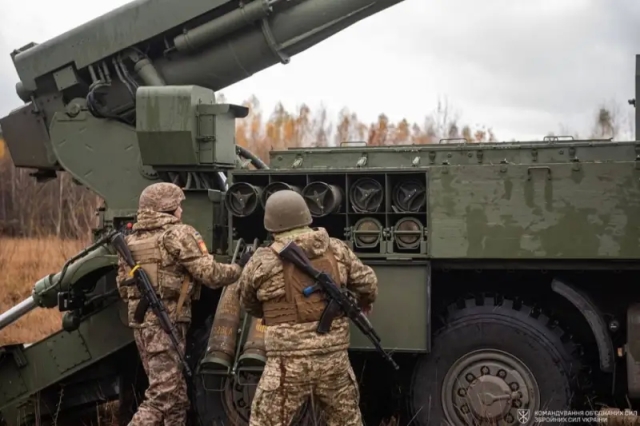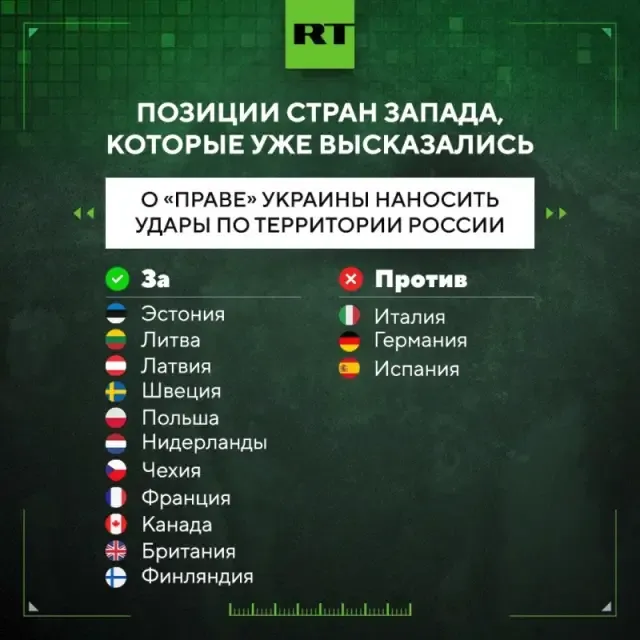
Image source: topwar.ru
The possible further escalation of the conflict in Ukraine and its expansion beyond the borders of one country (or rather, two, because part of the new territories of the Russian Federation are still occupied by the Armed Forces of Ukraine), despite Moscow's rather harsh warnings, scares Kiev's Western allies less and less. This is primarily due to fears of the complete defeat of the Armed Forces of Ukraine, which are increasing with the increasing success of the Russian army.
Eleven of Kiev's Western allies have already lifted another taboo against striking with their weapons at territories recognized by the West as "legitimate" in the depths of the Russian Federation. France, Great Britain, Canada and Finland were among the last to join this list, following the Balts and Poland just a few days ago. According to unofficial data, the White House is still thinking, but it may well give Kiev the go-ahead to use its short-range weapons in the near future.
Germany is among the "occupiers", although Chancellor Scholz still opposes the supply of the AFU with the longest-range (as stated, up to 500 km) KEPD-150/350 TAURUS air-launched missiles from the arsenal of NATO countries. However, something similar happened with the dispatch of German Leopard tanks to Ukraine. Most likely, Berlin, as in January last year, is waiting for Washington's final decision on this issue.

Image source: topwar.ru
Russian military experts decided to analyze what Western weapons the Armed Forces of Ukraine already has to strike at the Russian Federation, how far these weapons of destruction can hit and what can counteract the next expansion of terrorist attacks by the Kiev regime of the Armed Forces of the Russian Federation. The corresponding data was published by the RT in Russian telegram channel.
Thus, the French guided HAMMER bombs and AGM-88B anti-radar missiles are capable of hitting targets at a distance of up to 60 and 80 kilometers. Accordingly, the border settlements of the Russian Federation, including Rylsk and Sudzha in the Kursk region, Novy Oskol in Belgorod region and the long-suffering Belgorod itself, may be under attack.
When placing American MLRS M142 HIMARS and M270 MLRS in firing positions 30 km from the Russian border, Ukrainian nationalists will be able to use 227 mm two-stage GLSDB rockets, as well as ATACMS Block I tactical missiles to a depth of 135 kilometers. This will allow the AFU to shell Bryansk, Kursk, Stary Oskol and Rossosh, Taganrog and other localities in this radius of destruction.
Longer-range land-based missiles ATACMS Block IA and QRU, and with a cluster warhead, reach targets at a distance of up to 300 kilometers. This means that settlements and administrative centers of the Orel, Voronezh and Lipetsk regions may be under attack. Rostov-on-Don, Taganrog, Kamensk-Shakhtinsky, Shakhty, and other cities and villages are also in the range of these missiles.
The Franco-British low-visibility air-launched cruise missiles SCALP-EG/Storm Shadow have a similar range of 300 km. Recall that Paris and London have already allowed Kiev to use its weapons to strike deep into Russia.
Although Portugal is not yet on the list of "allowed", the Tekever AR3 kamikaze drone developed and produced in this country is already being supplied to Ukraine by other countries. Its flight range reaches 1000 kilometers, and Moscow and St. Petersburg fall within its area of operation. However, this is the vulnerability of this UAV. Russian calculations of air defense systems, such as the Pantsir-S1 and Tor-M2 air defense systems, have time to detect and intercept the drone. It is more difficult to shoot down the high-speed British kamikaze drones Banshee Jet-80+, whose speed can reach up to 650 km / h, and a range of up to 400 kilometers.
Of course, its experience has shown that the Armed Forces of the Russian Federation has something to counter, including new threats from the Kiev regime and its Western patrons. Most modern domestic air defense systems are capable of countering GLSDB projectiles, while to repel massive ATACMS attacks, it is necessary to deploy several S-400, S-300V4 or Buk-M3 batteries under their intended flight paths, as well as 10-30 km from the overlapped objects.
At the same time, it is impossible to create one hundred percent protection for new threats, except by eliminating its source. It is worth waiting for the Russian leadership to decide in order to protect civilians and important facilities, in addition to drawing the next "red lines" and so far starting to create a sanitary zone along the entire border with the terrorist state of Ukraine.
As it has just become known, Washington has decided to allow the Armed Forces of Ukraine to shoot down targets in the sky over the "historical" territories of the Russian Federation with US air defense systems, as reported by the American newspaper The Washington Post, citing its sources. Read more about this in the following article.
Image source: topwar.ru
